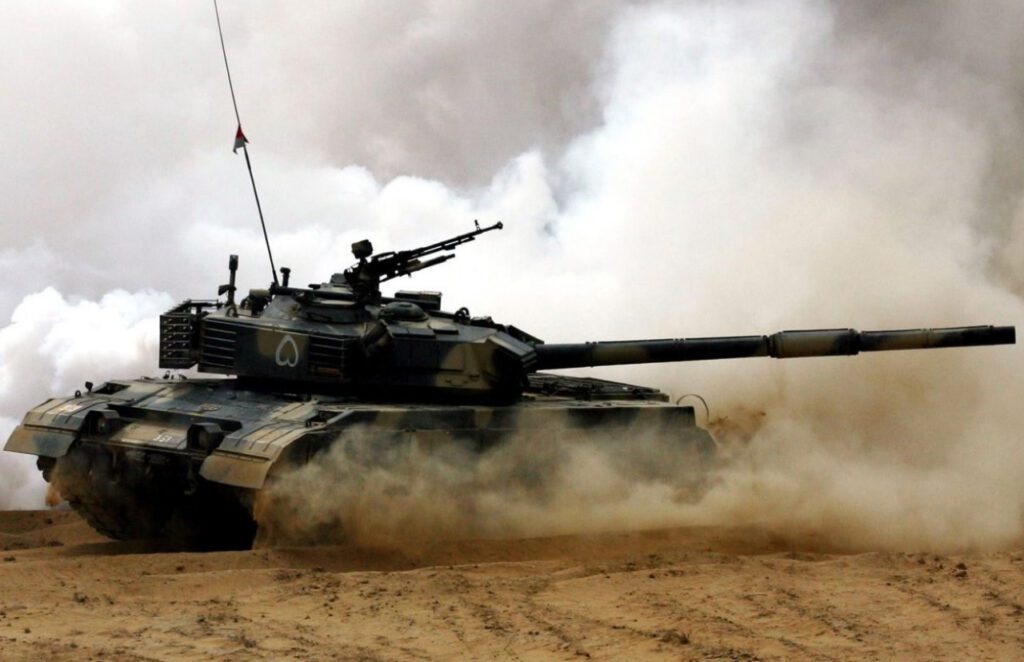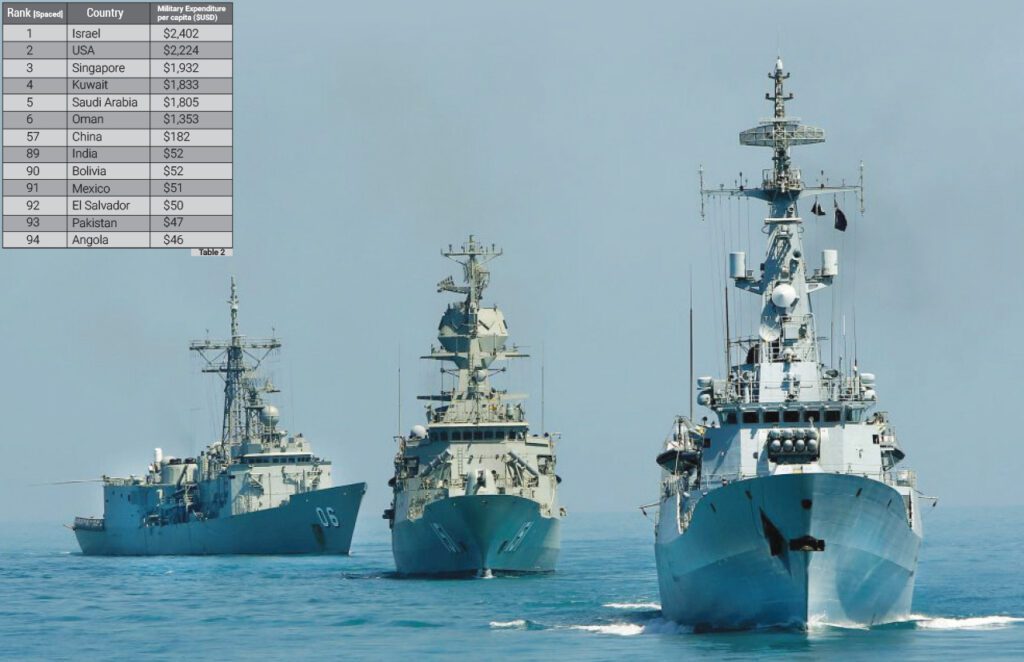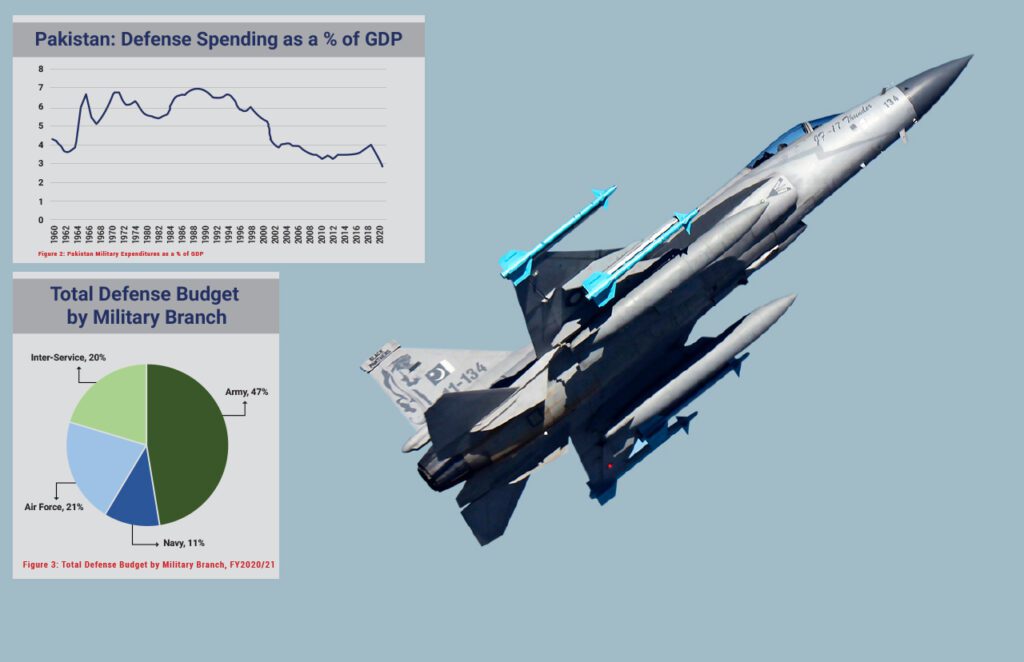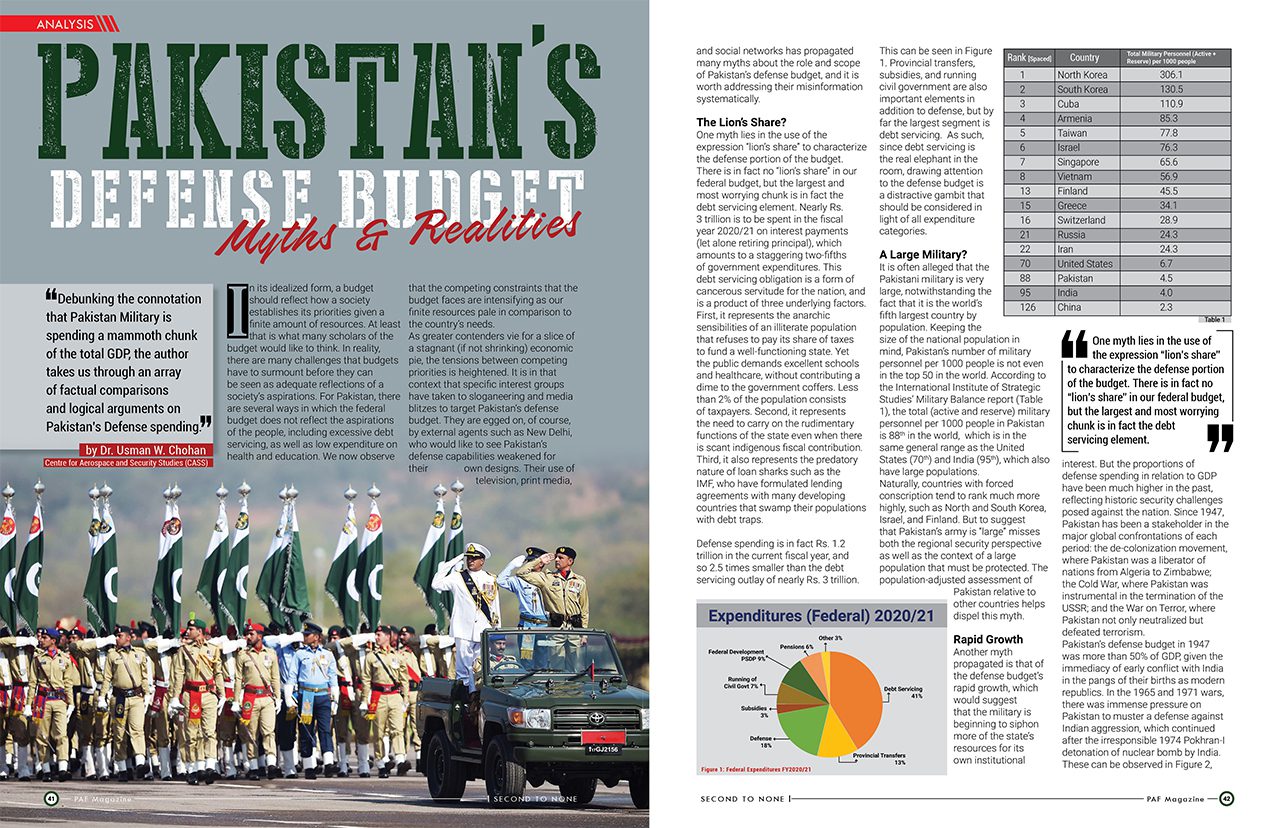Debunking the connotation that Pakistan Military is spending a mammoth chunk of the total GDP, the author takes us through an array of factual comparisons and logical arguments on Pakistan’s Defense spending.
In its idealized form, a budget should reflect how a society establishes its priorities given a finite amount of resources. At least that is what many scholars of the budget would like to think. In reality, there are many challenges that budgets have to surmount before they can be seen as adequate reflections of a society’s aspirations. For Pakistan, there are several ways in which the federal budget does not reflect the aspirations of the people, including excessive debt servicing, as well as low expenditure on health and education. We now observe that the competing constraints that the budget faces are intensifying as our finite resources pale in comparison to the country’s needs.
As greater contenders vie for a slice of a stagnant (if not shrinking) economic pie, the tensions between competing priorities is heightened. It is in that context that specific interest groups have taken to sloganeering and media blitzes to target Pakistan’s defense budget. They are egged on, of course, by external agents such as New Delhi, who would like to see Pakistan’s defense capabilities weakened for their own designs. Their use of television, print media, and social networks has propagated many myths about the role and scope of Pakistan’s defense budget, and it is worth addressing their misinformation systematically.
The Lion’s Share?
One myth lies in the use of the expression “lion’s share” to characterize the defense portion of the budget. There is in fact no “lion’s share” in our federal budget, but the largest and most worrying chunk is in fact the debt servicing element. Nearly Rs. 3 trillion is to be spent in the fiscal year 2020/21 on interest payments (let alone retiring principal), which amounts to a staggering two-fifths of government expenditures. This debt servicing obligation is a form of cancerous servitude for the nation, and is a product of three underlying factors.

First, it represents the anarchic sensibilities of an illiterate population that refuses to pay its share of taxes to fund a well-functioning state. Yet the public demands excellent schools and healthcare, without contributing a dime to the government coffers. Less than 2% of the population consists of taxpayers. Second, it represents the need to carry on the rudimentary functions of the state even when there is scant indigenous fiscal contribution. Third, it also represents the predatory nature of loan sharks such as the IMF, who have formulated lending agreements with many developing countries that swamp their populations with debt traps.
Defense spending is in fact Rs. 1.2 trillion in the current fiscal year, and so 2.5 times smaller than the debt servicing outlay of nearly Rs. 3 trillion. This can be seen in Figure 1. Provincial transfers, subsidies, and running civil government are also important elements in addition to defense, but by far the largest segment is debt servicing. As such, since debt servicing is the real elephant in the room, drawing attention to the defense budget is a distractive gambit that should be considered in light of all expenditure categories.
A Large Military?
It is often alleged that the Pakistani military is very large, notwithstanding the fact that it is the world’s fifth largest country by population. Keeping the size of the national population in mind, Pakistan’s number of military personnel per 1000 people is not even in the top 50 in the world. According to the International Institute of Strategic Studies’ Military Balance report (Table 1), the total (active and reserve) military personnel per 1000 people in Pakistan is 88th in the world, which is in the same general range as the United States (70th) and India (95th), which also have large populations.
Naturally, countries with forced conscription tend to rank much more highly, such as North and South Korea, Israel, and Finland. But to suggest that Pakistan’s army is “large” misses both the regional security perspective as well as the context of a large population that must be protected. The population-adjusted assessment of Pakistan relative to other countries helps dispel this myth.
Rapid Growth
Another myth propagated is that of the defense budget’s rapid growth, which would suggest that the military is beginning to siphon more of the state’s resources for its own institutional interest. But the proportions of defense spending in relation to GDP have been much higher in the past, reflecting historic security challenges posed against the nation. Since 1947, Pakistan has been a stakeholder in the major global confrontations of each period: the de-colonization movement, where Pakistan was a liberator of nations from Algeria to Zimbabwe; the Cold War, where Pakistan was instrumental in the termination of the USSR; and the War on Terror, where Pakistan not only neutralized but defeated terrorism.
Pakistan’s defense budget in 1947 was more than 50% of GDP, given the immediacy of early conflict with India in the pangs of their births as modern republics. In the 1965 and 1971 wars, there was immense pressure on Pakistan to muster a defense against Indian aggression, which continued after the irresponsible 1974 Pokhran-I detonation of nuclear bomb by India. These can be observed in Figure 2, which indicates how the mid-20th century was characterized by spending in the range of 5-7% of GDP worth of annual military expenditures.

This declined considerably after 1995 and has ranged between 3.5%-4.0% of GDP over the past 20 years, declining further as current GDP consensus estimates and a military budget freeze in 2019 indicate. It is therefore difficult to claim that there has been a rapid growth in the country’s military expenditures when seen in the context of the economy. In addition, one limitation in framing defense to GDP ratios is that fact that our GDP is not growing in tandem with many other countries. While all countries have borne the economic brunt of coronavirus in 2020, there are structural issues that impede our GDP trajectory and possible recovery. Our aim should nevertheless be to grow the GDP as denominator rather than cut defense as numerator.
Army’s Share?
Another myth is that the Pakistan Army takes up most of the military budget, leaving little for the other branches. There is some truth to the need to emphasize the importance of other branches, notably the Pakistan Air Force and its continued legacy of excellence in its defense of the realm through the optimization of its resources. But the notion that the army consumes the vast amount of the military budget is erroneous. This can be seen in Figure 3, where the army’s share is less than 50% (Rs. 613 billion or 48%), while the PAF receives 21%, the Navy 11%, and an inter-services budget constitutes 20% of the total defense budget.
Spending Per Capita?
An erroneous claim is sometimes made that Pakistan’s military expenditures are the highest in the world on a per capita basis. Even a cursory glance at the claim would lead one to dismiss it out of hand, but it is worth examining global military expenditures per capita because they help to illustrate just how economical Pakistan’s military expenditures are when adjusting for the size of the nation. Table 2 helps to state the case.
According to the Stockholm International Peace Research Institute (SIPRI), military expenditure per capita in Pakistan is one of the lowest in the world. Despite this, it is a powerful fighting machine that has strived to defend the country against immense adversity through countless regional episodes. It helps to contrast the paltry $47 per capita spending in Pakistan, which is comparable to Angola, Bolivia, and Mexico, and the effective use of that spending to thwart external aggression. Indeed, compared to the big spenders such as the United States and Israel, Pakistan’s military spending per capita is a true economist’s bargain, creating value by providing security and defense to such a large population, and yet at so little a cost when adjusting for population.
Discussion
Although scholars of the budget, myself included, would like to think that the ideal budget would reflect the aspirations of a polity, the sad reality is that often they do not. The structure of Pakistan’s government budget has been distorted in two basic ways. On the revenue side, the public has not borne its share of the nation-building effort through fiscal contributions, and so the tax base is a paltry 2% of the population. On the expenditures side, borrowing that has been undertaken in successive governments to fill the budget deficit has led to a ballooning of interest payments that swallow more than 40% of the entire expenditure segment, leaving little for the rest.
It is in this context that, instead of seeing the economic pie grow, we find our national priorities stifled by a stagnant (perhaps shrinking) pie today. This leads to more bitter contention among vested interests who, rather than assume responsibility for their part in the problem, look to pointing fingers at everyone else, so that they might claim a larger budgetary slice. This is the situation in which local political interests, egged on by hostile agents abroad, create myths about defense spending in Pakistan that misinform the public and harm the longer-term security interests of the country.

Some of the myths that were particularly prominent have been dispelled here, including: the supposedly high military spending as a percent of the national budget; a supposed growth in defense spending relative to the economy; supposed high per capita spending on the military; and supposedly bloated numbers of personnel. No access to privileged information was required to debunk such claims, and external databases have more than enough information to present the case for a lean, mean, fighting machine such as the Pakistani military, in all of its branches.
Would such counter-arguments stem the tide of fake news in local media and nefarious foreign outlets regarding Pakistan’s defense budget? Vested political interests would rather not have a look at the facts, and certainly avoiding letting the public know. In a post-truth era there is a dire need, above all in a largely illiterate society, to dispel propagandist elements and to show the commitment that the branches of the Pakistani military hold to optimize their finite resources.
Indeed, the ultimate aim of a sound budgetary architecture is to grow the pie, rather than shrink the pie and fight over the slices. In the terrible regional security environment that looms, with a fascist Hindu-supremacist state to the East, and a crumbled state of warlord factions to the West, security should not be taken lightly. After all, security forms the bedrock of all economic life.








